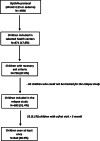Incidence of relapse following a new approach to simplifying and optimising acute malnutrition treatment in children aged 6-59 months: a prospective cohort in rural Northern Burkina Faso
- PMID: 33996040
- PMCID: PMC8080230
- DOI: 10.1017/jns.2021.18
Incidence of relapse following a new approach to simplifying and optimising acute malnutrition treatment in children aged 6-59 months: a prospective cohort in rural Northern Burkina Faso
Abstract
The present study aimed to determine the 3-month incidence of relapse and associated factors among children who recovered under the Optimising treatment for acute MAlnutrition (OptiMA) strategy, a MUAC-based protocol. A prospective cohort of children successfully treated for acute malnutrition was monitored between April 2017 and February 2018. Children were seen at home by community health workers (CHWs) every 2 weeks for 3 months. Relapse was defined as a child who had met OptiMA recovery criteria (MUAC ≥ 125 mm for two consecutive weeks) but subsequently had a MUAC < 125 mm at any home visit. Cumulative incidence and incidence rates per 100 child-months were estimated. Multivariable survival analysis was conducted using a shared frailty model with a random effect on health facilities to identify associated factors. Of the 640 children included, the overall 3-month cumulative incidence of relapse was 6⋅8 % (95 % CI 5⋅2, 8⋅8). Globally, the incidence rate of relapse was 2⋅5 (95 % CI 1⋅9, 3⋅3) per 100 child-months and 3⋅7 (95 % CI 1⋅9, 6⋅8) per 100 child-months among children admitted with a MUAC < 115 mm. Most (88⋅6 %) relapses were detected early when MUAC was between 120 and 124 mm. Relapse was positively associated with hospitalisation, with an adjusted hazard ratio (aHR) of 2⋅06 (95 % CI 1⋅01, 4⋅26) for children who had an inpatient stay at any point during treatment compared with children who did not. The incidence of relapse following recovery under OptiMA was relatively low in this context, but the lack of a standard relapse definition does not allow for comparison across settings Closer follow-up with caretakers whose children are admitted with MUAC < 115 mm or required hospitalisation during treatment should be considered in managing groups at high risk of relapse. Training caretakers to screen their children for relapse at home using MUAC could be more effective at detecting early relapse, and less costly, than home visits by CHWs.
Keywords: AM, acute malnutrition; Acute malnutrition; CHWs, community health workers; CIs, confidence intervals; CORTASAM, Council of Research & Technical Advice on Acute Malnutrition; Children; HAZ, height-for-age Z-score; IQR, interquartile range; Incidence; MAM, moderate acute malnutrition; MUAC, mid-upper arm circumference; MUAC-based and reduced doses protocol; OptiMA, Optimising treatment for acute MAlnutrition; RDT, rapid diagnostic tests; RUTF, ready-to-use therapeutic food; Relapse; SAM, severe acute malnutrition; WHO, World Health Organization; WHZ, weight-for-height Z-score; West Africa; aHR, adjusted hazard ratio; sd, standard deviation.
© The Author(s) 2021.
Figures


Similar articles
-
New approach to simplifying and optimising acute malnutrition treatment in children aged 6-59 months: the OptiMA single-arm proof-of-concept trial in Burkina Faso.Br J Nutr. 2020 Apr 14;123(7):756-767. doi: 10.1017/S0007114519003258. Epub 2019 Dec 10. Br J Nutr. 2020. PMID: 31818335 Free PMC article.
-
Impact of reduced dose of ready-to-use therapeutic foods in children with uncomplicated severe acute malnutrition: A randomised non-inferiority trial in Burkina Faso.PLoS Med. 2019 Aug 27;16(8):e1002887. doi: 10.1371/journal.pmed.1002887. eCollection 2019 Aug. PLoS Med. 2019. PMID: 31454351 Free PMC article. Clinical Trial.
-
Anthropometry at discharge and risk of relapse in children treated for severe acute malnutrition: a prospective cohort study in rural Nepal.Nutr J. 2021 Apr 5;20(1):32. doi: 10.1186/s12937-021-00684-7. Nutr J. 2021. PMID: 33820545 Free PMC article.
-
Severely malnourished children with a low weight-for-height have similar mortality to those with a low mid-upper-arm-circumference: II. Systematic literature review and meta-analysis.Nutr J. 2018 Sep 15;17(1):80. doi: 10.1186/s12937-018-0383-5. Nutr J. 2018. PMID: 30217196 Free PMC article.
-
Use of Mid-Upper Arm Circumference by Novel Community Platforms to Detect, Diagnose, and Treat Severe Acute Malnutrition in Children: A Systematic Review.Glob Health Sci Pract. 2018 Oct 4;6(3):552-564. doi: 10.9745/GHSP-D-18-00105. Print 2018 Oct 3. Glob Health Sci Pract. 2018. PMID: 30185435 Free PMC article.
Cited by
-
Post-Recovery Relapse of Children Treated with a Simplified, Combined Nutrition Treatment Protocol in Mali: A Prospective Cohort Study.Nutrients. 2023 Jun 5;15(11):2636. doi: 10.3390/nu15112636. Nutrients. 2023. PMID: 37299599 Free PMC article.
-
Time to readmission and associated factors after post treatment discharge of severe acute malnourished under-five children in Pawe General Hospital.J Health Popul Nutr. 2022 Jul 8;41(1):29. doi: 10.1186/s41043-022-00308-8. J Health Popul Nutr. 2022. PMID: 35804464 Free PMC article.
-
Lay health workers in primary and community health care for maternal and child health: identification and treatment of wasting in children.Cochrane Database Syst Rev. 2023 Aug 30;8(8):CD015311. doi: 10.1002/14651858.CD015311. Cochrane Database Syst Rev. 2023. PMID: 37646367 Free PMC article.
References
-
- Black RE, Victora CG, Walker SP, et al. (2013) Maternal and child undernutrition and overweight in low-income and middle-income countries. Lancet (Lond Engl) 382, 427–451. - PubMed
-
- UNICEF/WHO/World Bank Group. Levels and trends in child malnutrition. Key findings of the 2019 edition [Internet]. https://www.who.int/nutgrowthdb/jme-2019-key-findings.pdf?ua=1
-
- World Health Organization (WHO) (2013) Guideline: Updates on the Management of Severe Acute Malnutrition in Infants and Children. Geneva: WHO. - PubMed
Publication types
MeSH terms
LinkOut - more resources
Full Text Sources
Other Literature Sources
Medical
Miscellaneous

